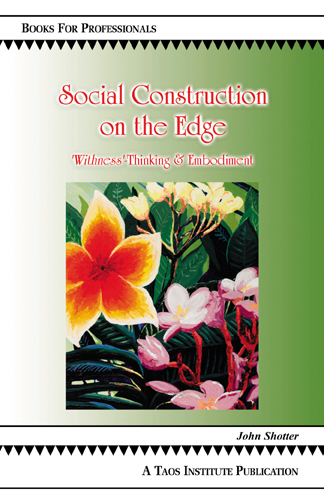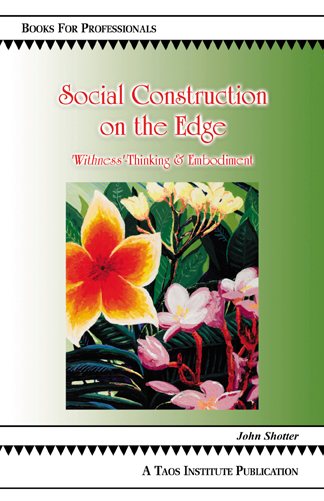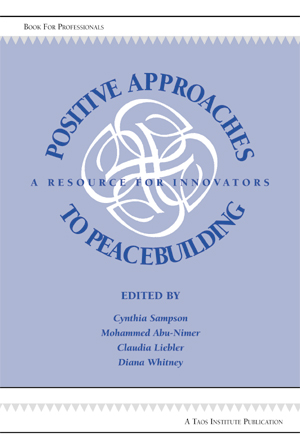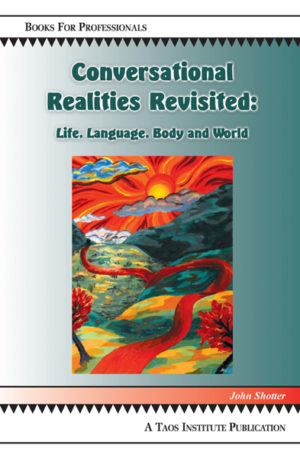Description
Social Construction on the Edge: ‘Withness’-Thinking and Embodiment
by John Shotter
Taos Institute Publications, 2010
Price: $25.00 US plus shipping and handling
Paperback, 260 pages
ISBN:
13-digit: 978-0-981907-64-2
Description:
This is a book for practitioners, for people who, like crafts-persons or sports-people, must continually shape or fashion their conduct both within the immediate allowances or opportunities for action afforded them by their circumstances, whilst at the same time, aiming at an overall goal of ‘bettering’ those circumstances, and their performances within them, in some way. The overall approach taken in this collection of essays is ‘on the edge’ of social constructionism in that – rather than emphasizing a “linguistic” or an “interpretative” turn – it emphasizes the spontaneous, expressive-responsiveness of our living bodies as providing the ‘background glue’ that holds us together in all our relationships, both with all the other people around us and with all the events also occurring in our surroundings. It thus emphasizes how our living, bodily embedding in this previously unnoticed background, and the ways in which events in it both ‘call out’ expressive responses from us, whilst leading us to ‘resist’ others, exerts much more of an influence on our actions than previous versions of social constructionism seem to allow.
Review: Shotter, J. 2010. Social Constructionism od the Edge
“Being a good organizer, a good listener, a careful reader, a good speaker, etc., are all to do more with our learning how to be in the world (ontology) than with our gaining knowledge of it” p. vi
What happens, when two or more living beings meet and start to respond to each other? It may sound like a basic and rather trivial question of social psychology but there is not any single answer to it and the accounts taken by various scholars through the ages enormously differ between each other. But if we really want to look properly into this answer, to go inside and stay there – not leaving to theoretical sky – John Shotter is the right guide to go with. The journey with him is not easy, but is exciting, interesting, thought provoking and refreshing.
His book is a must-have for people who was already touched by his previous writings but did not have a chance to elaborate on his ideas in a detail. For the most part, the reader will find delibaretely chosen essays and presentations in which we can watch the development of his ideas. The first and the two last chapters are original so as introduction parts for each chapter. In the whole text, you will find a lot of references on Shotter´s favourite authors as Bakhtin, Wittgenstein, Merleay-Ponty, Vygotskij, and many others.
The book is also a good start for people who still did not have a chance to read Shotter. Especially for those who are fed up with psychology books that offer just ready to use toolkits of how to behave, how to live life more easily. It is for those people who want to reflect more deeply on their practices and on life today which is not easy at all. For people who does not want to live their lives acccording to prepared plans – but rather want to be responsive to their surroundings, want to act spontaneously and not as a sole selfish actors, but more likely in a sync with others. And for practitioners who also want to work like that – but do not have support in their institutional background. Shotter provides here an account of how this way of living is intelligible, ethical, worth trying and also exciting.
The style of the book is more like music composition (to borrow Shotter´s own metaphore) than a scientific rational text. There are repetitive parts, there are unique pearls, quotes – but what is the most important is the new quality that the whole composition creates. The style is like swimming in waves – it is very intensive, you must watch around very often not to get lost – and it feels good.
In the last original chapter Shotter reflect upon this style of writing in this sense: „I want to try to write “participatively,” i.e., from within an ongoing involvement within the activities in question, not as a detached outsider to them“. (202) And even his book is not a journal reading, it is really as close to practice as it can be.
A practice domain where Shotter left notable footprints is psychotherapy. For Shotter, human problems cannot be solved by explaining – but therapist with a client can – in common activity – find new ways of descriptions, of understanding, „to create new ways of ‘going on’in their lives by interconnecting and relating old facts in new ways“ 43. This way of understanding was originally called by Shotter and Katz „relationally-responsive way of understanding“.
In this book, you can find „case descriptions“ from psychotherapy practice – brilliantly commented – that exactly show what Shotter means by his (sometimes odd) new words – especially by „knowing how to go on“ what he states is a goal of psychotherapy. Right at the beginning he also states his great inspiration that he found in Tom Andersen, Norwegian psychotherapist.
In a sense, Shotter launches a new project with a new worldview and he needs new metaphores, new words to be able to achieve this. He proposes new relational practice in which we will notice things that were left unnoticed before and will be sensitive to things that we neglected before. It is also his writing where he wants to show this new project. He wants to make the writing not static but more living, to enable readers to find their own connections
However, he does not want invent another completeley new theory. To the contrary, he wants to look at what we already know but he invites us to see it from a new, surprising perspective. „…by provoking us into adopting a “new attitude” towards our surroundings – where, by a “new attitude,” I mean here a new way of relating or orienting ourselves towards the others and othernesses around us.“ 12 He builts on thinkers as Vico, Wittgenstein, James, Vygotskij who were taught at universitities even hundred years ago. But with his work he reminds us these important thoughts that go often unnoticed and are not reflected in the psychological research and practice at all. He started to read these „old“ authors also because he found that they are often misunderstood, wrongly cited, that their voice is missing.
He switches from the Cartesian view of the world – a view that we can manage the world – especially by individual actions. He refuses the scepticims of Foucault who states that we cannot escape from the dominant discourse with its rules, even if we comment on them. Shotter says that there is an escape – through finding new – poetic – ways of talk and being.
Regarding research, he suggests to find new ways of life, new practices that we will develop together along with our „studied ones“. His notion of change is very critical and crucial for psychological research but also for practitioners. He talks of extraordinary changes, that happen surprisingly, unexpectedly, changes in the character of what we call reality.
He does not spend time to explain what social constructionism is – it is clearly visible in his „doings“, in his writing. But why is there „on the edge“ in the title? He distinguishes his approach from those versions of social constructionism being closely associated with poststructuralism, deconstructionism which „ignore or preclude the spontaneous, expressive-responsiveness of our living bodies which, as we shall see, provides the ‘background glue’holding us together in all our relationships, both to the other people as well as to all the other events occurring in our surroundings“ (p. v) He likes the term „ontological version“ of SC (Corcoran, 2009)
John Shotter takes us in this book to a new world – but not entirely new. It is the same world we are in but through Shotter´s lenses we are able to see many new compositions and connections of things that we have not noticed before – maybe because they have seemed too ordinary or too uninteresting to us. And this is why this book is good for every practitioner: sometimes we really need to check our „doings“ in some other way – to know how to go on.







Comments are closed here.